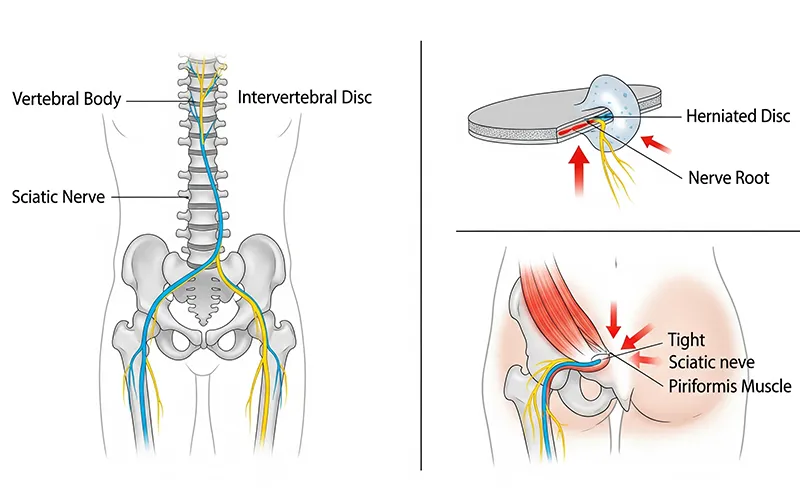Imagine a pain that starts in your lower back and shoots down your leg, a constant, burning reminder of an irritated nerve. This is the reality of sciatica, a condition caused by the compression or irritation of the mighty sciatic nerve. Since sciatica is fundamentally a problem of nerve compression—often from a herniated disc or tight muscle—conventional treatments that only mask the pain often fall short. This is where chiropractic medicine offers a different perspective. By focusing on non-surgical techniques to correct the underlying spinal misalignments and muscular tension, chiropractic care provides a natural, evidence-based solution.
Introduction: A Natural Path to Sciatica Relief
1.1. Understanding Sciatica
Sciatica itself is not a disease but a symptom. It occurs when the sciatic nerve—the body’s largest nerve extending from the lower back through the legs—is compressed or irritated. This often leads to pain, tingling, numbness, or weakness that usually affects only one side of the body.
The discomfort may appear in the lower back, hip, or leg and typically intensifies when sitting, coughing, or sneezing. In advanced cases, individuals may feel a sharp burning sensation, muscle weakness, or difficulty moving the foot. To achieve lasting relief, it is essential to identify and correct the underlying cause of the nerve compression.
1.2. How Chiropractic Views Sciatica
Chiropractic medicine emphasizes the idea that spinal misalignments or restricted movement can negatively affect nerve function and overall health. In sciatica cases, chiropractic care focuses on non-surgical techniques to reduce nerve irritation and restore mobility. Instead of only masking pain with medication, chiropractors aim to correct the root issue with a tailored treatment plan.
Treatment is usually multi-dimensional, combining spinal adjustments, soft tissue work, rehabilitative exercises, and lifestyle guidance. The purpose is not only to alleviate pain but also to improve spinal function and lower the risk of recurring symptoms.
2. Identifying the Causes of Sciatica
Since sciatica is a symptom, an accurate diagnosis is critical. Different spinal and muscular conditions may irritate or compress the nerve, so treatment must be tailored to the root problem.
2.1. Spinal Causes
The majority of sciatica cases are linked to spinal structural issues, such as:
Herniated Disc (Slipped Disc): The most frequent cause, where the disc material presses on the nerve root.
Spinal Stenosis: Narrowing of the spinal canal, often age-related, compressing the nerve.
Spondylolisthesis: A vertebra slipping forward onto the one beneath it.
Other Factors: Bone spurs, tumors, cysts, or general spinal degeneration.
2.2. Herniated Disc vs. Piriformis Syndrome
Because symptoms can overlap, distinguishing between spinal and muscular origins of pain is essential.
Piriformis Syndrome: Caused by tension or spasm in the piriformis muscle in the buttock, leading to nerve compression. Pain is localized in the buttock and worsens with sitting, stair climbing, or running.
Herniated Disc: A spinal condition starting in the lower back, with pain radiating down the leg, often triggered by bending or lifting.
Key distinctions:
Cause: Herniated Disc = spinal; Piriformis Syndrome = muscular.
Pain Location: Herniated Disc = lower back + leg; Piriformis Syndrome = buttock + leg.
Triggers: Herniated Disc = lifting, bending, sitting; Piriformis Syndrome = prolonged sitting, stairs.
Symptoms: Herniated Disc = numbness/weakness; Piriformis Syndrome = stiffness without leg weakness.
3. Chiropractic Care for Sciatica: Core Methods
Chiropractors employ various methods, depending on the patient’s diagnosis:
Spinal Adjustments: Gentle manipulation to realign vertebrae and reduce nerve pressure.
Spinal Decompression Therapy: Non-surgical stretching of the spine to relieve disc and nerve compression.
Soft Tissue Therapy: Massage and manual techniques targeting muscles like the piriformis to reduce tension and spasms.
Complementary Modalities:
Ultrasound for circulation and swelling reduction.
TENS unit for pain control.
Cold laser therapy for inflammation.
Heat and cold packs for muscle relaxation and swelling.
4. Research and Clinical Evidence

4.1. Effectiveness of Chiropractic
Clinical studies highlight the benefits of chiropractic care for sciatica:
Success rates up to 72% in some trials.
Comparable pain relief to surgery for certain patients.
Reduction in opioid dependence—patients were significantly less likely to need pain medication when treated with spinal manipulation first.
4.2. Guidelines and Safety
Organizations such as the American College of Physicians and CDC recommend non-drug, non-invasive therapies like spinal manipulation as first-line care. Chiropractic treatments are considered low-risk when delivered by licensed professionals, making them a safe option compared to invasive procedures.
5. Beyond the Clinic: Exercises and Lifestyle
Recovery isn’t limited to treatment sessions. Chiropractors often provide patients with personalized exercise and lifestyle recommendations, including:
Stretching: Targeting hamstrings and piriformis muscles to relieve nerve pressure.
Strengthening: Core and back exercises to support spinal stability and prevent relapse.
Daily Adjustments: Ergonomic advice, posture training, safe lifting, and encouragement of low-impact activities like swimming or walking.
6. Chiropractic vs. Other Treatment Options
Chiropractic Care: Non-invasive, root-cause oriented, typically brings improvement within weeks.
Physical Therapy: Emphasizes long-term strengthening and flexibility.
Medications: Provide temporary relief but do not fix the underlying cause.
Injections: Offer strong but temporary pain relief.
Surgery: Reserved for severe cases with persistent weakness or loss of function.
7. Recovery Timeline and Progress Signs

Many patients notice improvement within the first week of treatment, with 6–12 sessions recommended for moderate cases. Signs of progress include reduced pain intensity, better mobility, decreased muscle spasms, and pain “centralizing” toward the spine.
FAQs
Is chiropractic safe? Yes, when provided by licensed professionals.
How many sessions are needed? Initial relief often in a week; moderate cases require 6–12 visits.
When to see a medical doctor? If pain persists, worsens, or includes bowel/bladder dysfunction.
Can I exercise? Low-impact activities are encouraged—avoid long periods of inactivity.
Conclusion
Sciatica treatment requires identifying and correcting the source of nerve irritation. Chiropractic care provides a natural, evidence-based, and comprehensive solution by combining spinal adjustments, soft tissue therapies, and supportive home practices. With strong scientific backing and safety advantages, it offers patients a practical alternative to invasive treatments, empowering them to take an active role in their long-term recovery.
Ourchiropractic carespecialists in Dubai can provide a comprehensive assessment and a personalized treatment plan for your sciatica. Contact us today to start your recovery journey.





